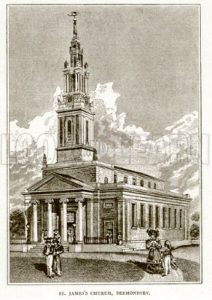 On a damp Saturday morning in mid-March, an enthusiastic group of SSLSO members arrived at the grand entrance to St James’ Church in Bermondsey to visit the historic, 1829 Bishop organ.
On a damp Saturday morning in mid-March, an enthusiastic group of SSLSO members arrived at the grand entrance to St James’ Church in Bermondsey to visit the historic, 1829 Bishop organ.
The organ is contemporary with the church and it is a large instrument even by today’s standards; it had to be considering that on completion, it was thought that the church could seat up to 1200 people. To reach the organ, we ascended a majestic, winding staircase to the West gallery which can easily accommodate a choir – in addition to the organ and blowing plant that it already contains.
Everyone had a play and explored some of the beautiful combinations and sonorities that the organ is capable of. Pieces by Mendelssohn, Bach and Boyce were heard by the many visitors to the church. The organ contains the earliest clarabella rank in existence – a stop invented and developed by James Chapman Bishop himself. 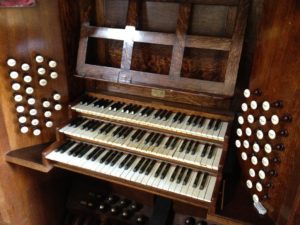 Interestingly, there was a little picture of J.C.’s gravestone on the wall near the organ! We all marvelled at the width of the pipes in the pedal department – they almost rival the columns at the entrance to the church.
Interestingly, there was a little picture of J.C.’s gravestone on the wall near the organ! We all marvelled at the width of the pipes in the pedal department – they almost rival the columns at the entrance to the church.
Of course, the most quirky aspect of the organ is the ability for another organist to play pedal notes on a small keyboard directly to the left of the main console. This feature is the only surviving example of its type in the UK and dates from a time when many British organs didn’t include a pedal department. Our host, St James’ organist Nick Herbert, told us that many of the early recitals featured three organists playing arrangements of Bach using this keyboard. SSLSO member William McVicker also gave us some fascinating background to the rapid developments (and experiments!) in organ building in the UK from the 1800’s to the 1840’s.
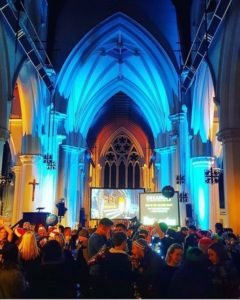 A couple of hours later, we arrived at St Giles’ Church in nearby Camberwell to visit an organ built by Bishop some 15 years later than the Bermondsey organ.
A couple of hours later, we arrived at St Giles’ Church in nearby Camberwell to visit an organ built by Bishop some 15 years later than the Bermondsey organ.
Despite similarities to its earlier cousin, the organ at St Giles’ is a very different instrument – having been designed by one Samuel Sebastian Wesley. S.S.W. had been the organist at the medieval church of St Giles’ before its destruction by fire in 1841. Wesley was by all accounts very happy during his time in Camberwell and was pleased to be asked back by the rebuilding committee to design a new organ, constructed by Bishop, ready for the new church’s consecration in 1844.
Ashley Valentine is the organist at St Giles’ and 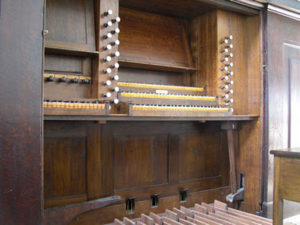 he gave some background about how Wesley came to be involved in the development of this large organ. He also told the story about the infamous concluding voluntary at the church’s consecration. Wesley was so taken with his creation that his voluntary turned into a recital – to the annoyance of the diocesan Bishop eager to retire to the vicarage for high tea – and the three organ blowers were paid to stop providing air so that Wesley’s improvisation came to a rather abrupt and bad-tempered end.
he gave some background about how Wesley came to be involved in the development of this large organ. He also told the story about the infamous concluding voluntary at the church’s consecration. Wesley was so taken with his creation that his voluntary turned into a recital – to the annoyance of the diocesan Bishop eager to retire to the vicarage for high tea – and the three organ blowers were paid to stop providing air so that Wesley’s improvisation came to a rather abrupt and bad-tempered end.
After another round of organ pieces, including the music of W. T. Best and S.S.W. himself, our own tea was served and another enjoyable organ trip was concluded.
Ashley Valentine
Here are some photos of the visit to StGiles
Andrew Chadney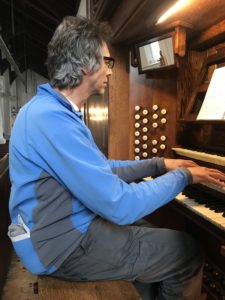 |
The Nave of St James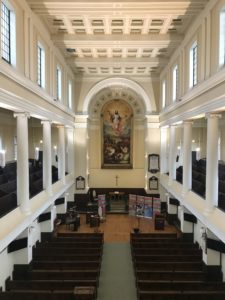 |
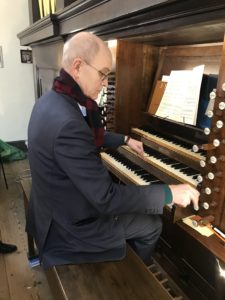 |
Samzu Agbaje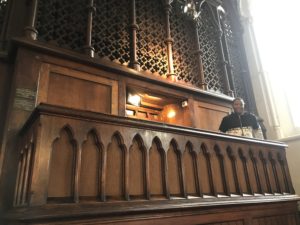 |

